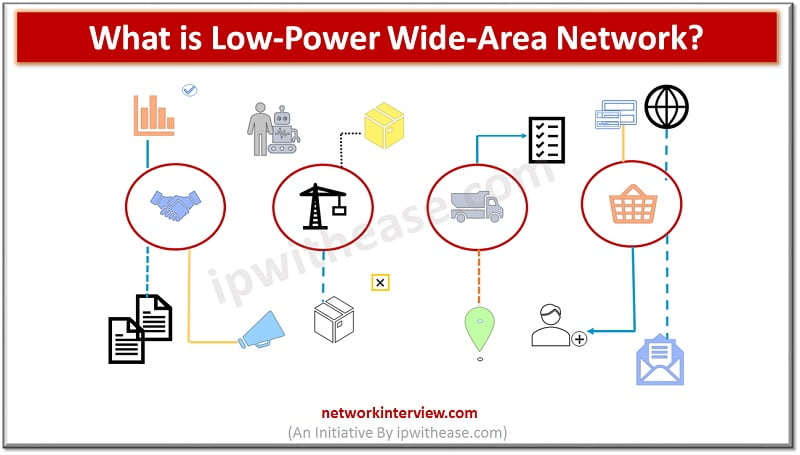
What is Low Power Wide Area Network (LPWAN)? Detailed Explanation
Low power wide area network (LPWAN) technologies offer a cost and power efficient wireless solution options for leveraging existing networks, global reach and strong built in security. They empowered and strengthened business case for IoT solutions as they help network operators to meet cost, coverage, and power consumption requirements for IoT applications. LPWAN provides an alternate to traditional cellular/M2M telecommunications coming in both licensed frequency spectrum (Cellular) and unlicensed frequency spectrum technology.
In this article we will learn more about Low power wide area network standard, its features, advantages, and limitations.
Low Power Wide Area Network (LPWAN)
Low-power wide-area network (LPWAN) are specifically created for M2M and IoT devices – it enables low power usage, long range wireless connectivity. It is emerged in 2013 and it is a generic term which refers a class network technologies which are designed to communicate without wires over relatively long distances using less power than any other conventional networks such as Wi-FI, satellite etc. Energy efficient and wider coverage is the two main characteristics of LPWAN. In IoT devices growth and increasing penetration which is expected to grow to 22 million in 2025, LPWANs will be key drivers in this growth.
Types of LPWAN technologies
Non-Cellular LPWA Networks –
Network based LPWA solutions such as Sigfox or LoRa use the existing cellular technologies to provide the services, such as LTE-M and NB-IoT. French start up created LoRaWAN which specialize in transmission of data packets between 0.3 and 50 Kbits per second (Kbps) and was acquired by Semtech, founder of the LoRa Alliance. It is an open source network that can be developed or operated by any company with only limitation of purchasing LoRa chips.
It ensures transferability between operators and benefit from roaming agreements between alliance members. Sigfox is LoRaWAN competitor, created in 2009 as a French initiative in the field of IoT technologies. Low speed networks require the use of Sigfox – certified transmitters and receivers and guarantees compatibility and facilities interpretability between all countries. (Covered).
Standardized Cellular LPWA Networks –
The 3GPP organization proposed two standards for IoT based one existing cellular network. LTE-M and NB-IoT to alleviate the issues of compatibility of M2M applications and reduction in production costs of communication modules. LTE-M technology offers more stable speed, reduced latency and better roaming capabilities as compared to its non-cellular rivals. LTE-M offers higher speeds of up to 1 Mb/s.
NB-Iot is a standard choice for telecommunication giants it uses 200 KHz frequency band and ideal for applications such as telemetry and large number of fixed assets in the field which require reduced data volumes where speed of transmission is not of primary importance.
Applications of Low Power Wide Area Network (LPWAN)
LPWAN networks offer multiple possibilities and can be used in diverse areas. We will look at some use cases which are already defined and already being tested and implemented in real life scenarios lets look at them.
Parking management –
LPWAN offers flexible solution to address parking management in city areas, IoT sensor identifies whether parking space is vacant or occupied and this information is used as an input for applications such as signs indicating how much parking space is vacant or available, where sites are located and any vehicle parked for too long. Use of low power LPWA is an ideal solution as its low power feature will save costs of changing all batteries of hundreds of parking space monitors.
Public and lighting infrastructure –
Multiple light bulbs installed on roads, sidewalks, crowded places, or lonely highway stretches and tracking which bulb went off and informing the authorities, LPWA could alert command center if light bulb is working or off.
Water and Pipe meters –
A pressure gauge communicating data readings to help to identify a leakage as pipelines run miles and ability to communicate over long distances where no network exists LPWA can be used in such underground penetration allowing monitoring of pipelines.
Small pallets –
While tracking shipments load is scanned and LPWA makes it possible to implement smart pallets to track movement of cargo and track if it is opened, dropped, or mishandled.
Pros and Cons of Low Power Wide Area Network (LPWAN)
PROS
- Low power consumption which enables devices to last up to 10 years on a single charge
- Optimized data transfer which supports small , intermittent blocks of data
- Low device unit cost
- Less number of base stations to provide coverage
- Easy network installation
- Dedicated network authentication
- Optimized for low throughout long or short distanced
- Enough indoor penetration and coverage
- Enhance security when LPWAN deployed in licensed spectrum
- Offers longer ranges from 5 KM to 30 KM
- High amount of penetration through walls and building basements
- Secured communication between nodes and gateways with encryption algorithms
CONS
- Supports low data rate hence not suitable for high data rate applications
- Offers high latency between end to end nodes so not ideal for low latency applications
Continue Reading:
What is WAN? Detailed Explanation
Tag:routing



